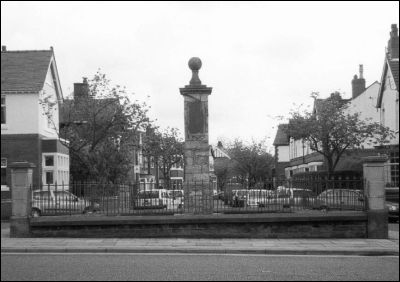|
 

DURING the Civil Wars, Wigan was the Royalist Headquarters for the North Western Counties. This was probably due to the fact that Lord Derby was the King's General and that Wigan was adjacent to Lathom House (Lord Derby's residence) and furthermore, many Royalist families resided in, or near to the town. The photograph above, illustrates the memorial raised to Sir Thomas Tyldesley who was killed in the Battle of Wigan Lane, which took place on the 25th August, 1651. A description of the battle is given as follows:- "A FINAL effort for the Royalist cause was made in 1651. The Earl of Derby arrived in England with 300 Manxmen and joined forces with the English collecting in Lancashire. He aimed to make Wigan his headquarters and had just reached within sight of the town when he came into contact with the Parliamentarians under Colonel Lilburn, to their mutual surprise. The Earl had a force of no more than 1,500 men and with a large contingent of the enemy on the rising bank of the Douglas on his left and a strong force lining the hedges on his right, it was hopeless to try and make the town. Both forces endeavoured to avoid battle but there was nothing for it but to engage, and a short but most sanguinary conflict ensued. After fortune had appeared to be favouring alternatively one side and then the other, the advantage finally went to Colonel Lilburn. The Earl of Derby (with two horses killed under him) and his colonels performed prodigies of valour, but all to no purpose. The Earl was himself severely wounded and fleeing into Wigan hid the night in the "Dog" Inn. His hat was found on the field pierced with many holes together with his Garter and other decorations. Among those slain were Lord Widderington, Colonel Boynton and Sir Thomas Tyldesley. A monument was later erected as "A High Act of Gratitude" on the spot where the last named was killed. THE inscription on this monument may be of interest, so we quote it "in extenso." INSCRIPTION ON
TYLDESLEY MONUMENT."AN high act of gratitude which conveys the memory of Sir Thomas Tyldesley to posterity, who served King Charles the 1st as Lieutenant Colonel at Edge Hill Battle after raising regiments of horse, foot and dragoons and for the desperate storming of Burton-upon-Trent over a bridge of thirty-seven arches, received the honour of Knighthood. He afterwards served in all the wars in great command, was then Governor of Lichfield and followed the fortunes of the Crown through the three Kingdoms and never compounded with the rebels though strongly invested, and on the 25th August A.D. 1651 was here slain commanding as Major General under the Earl of Derby, to whom the grateful erector, Alexander Rigby Esquire was cornet, and when he was High Sheriff of the County A.D. 1689, placed this high obligation on the whole family of the Tyldesleys to the noble example of their loyal ancestor." |
|